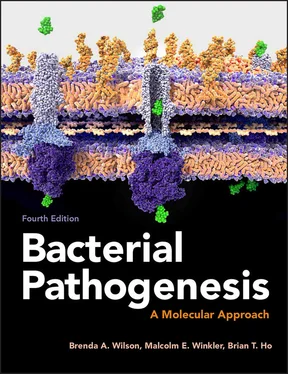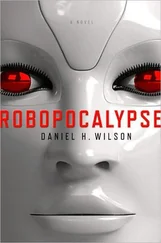Box 1-3.
Enterprising Bacteria Always on the Alert for New Infection Opportunities
An example of how bacteria can rapidly act to take advantage of new opportunities is provided by an outbreak of pneumonia in an intensive care ward. Many of the patients were very ill and were on respirators to support breathing. The type of respirator being used required that a tube be inserted deep into the airway of the lungs, an ideal conduit to carry bacteria deep into the lung, bypassing the normal respiratory defenses. After a number of previous cases of respirator-associated lung infections, hospital personnel have learned to be very careful not to contaminate the respirator itself or to allow bacterial contaminants to enter the air being forced into the lung.
No one, however, thought about mouthwash. Since patients on respirators are often unable to attend to their own dental hygiene, hospital staff workers use mouthwash to clean and freshen the mouth every day. The cause of the lung infections was identified as Burkholderia (formerly Pseudomonas) cepacia. Although this bacterial species is known to cause infections in people with lung diseases, such as cystic fibrosis, it is generally considered to be a relatively innocuous soil bacterium. In fact, B. cepacia is used as a biocontrol agent to degrade herbicides, such as 2,4,5-trichlorophenoxyacetic acid (2,4,5-T, a toxic defoliant also known as Agent Orange). The bacterium is ubiquitous in soil and water, but in this case apparently managed to contaminate many lots of the mouthwash, which did not contain alcohol to discourage bacterial growth. In effect, the hospital workers taking care of the patients on respirators were inoculating the patients’ teeth and gums daily with a contaminated mouthwash solution, which placed the bacteria in an ideal location to gain access to the lungs.
Source:
Centers for Disease Control and Prevention (CDC). 1998. Nosocomial Burkholderia cepacia infection and colonization associated with intrinsically contaminated mouthwash—Arizona, 1998. MMWR Morb Mortal Wkly Rep 47:926–928. [PubMed]
Another way in which modern medicine has affected the infectious disease picture is by increasing the human life span. The increasing number of elderly people, whose immune defenses are beginning to decline and who are more likely to be receiving therapies that undermine the defenses of their bodies, provides an expanding population of individuals highly susceptible to diseases. Put these elderly people in crowded conditions, such as those experienced in nursing homes, and an even greater opportunity is created for infectious diseases to spread.
Postsurgical and Other Wound Infections
Most recent studies of wound infections have focused on the infections that can be a serious complication of surgery (postsurgical infections). In the preantibiotic era, infections were a major complication of surgery. Regardless of how skillful the surgeon, an infection could kill the recipient of the most successful surgery. This may have been the origin of the grim old joke that the surgery was a success, but the patient died. Antibiotics changed all this and made routine surgery possible because antibiotics eliminated any bacteria that might have managed to penetrate the barrier of the surgical scrub and other hygienic procedures.
The first shadow in this rosy picture appeared when surgeons and other health care workers began taking patient survival for granted and became more lax in their time-consuming hygienic practices. Hospitals trying to save money began cutting budgets for nurses and janitors, individuals responsible for the cleanliness characteristic of hospitals in developed countries. To make matters worse, the bacteria often causing postsurgical problems tend to be resistant to antibiotics. These postsurgical infections have consequences for both patients and hospitals. Patients risk damage to major organs or even death, while hospitals and insurance companies bear significantly higher financial costs to care for these patients.
Not long ago, the state of Pennsylvania made history by publishing postsurgical infection data from its hospitals. Until this unprecedented move to transparency, infection rates in hospitals were secrets guarded almost as fiercely as classified CIA files. The reason is easy to understand. No hospital wants potential users of its facilities, especially people getting elective surgery, to identify the hospital as a place where people go in healthy and come out sick or even dead. The Pennsylvania figures confirmed what everyone in the infectious disease community already knew: patients who contract a postsurgical infection, especially one caused by antibiotic-resistant bacteria, cost over four times more to treat than people who do not contract an infection. Unfortunately, this type of statistic has attracted a lot more attention than the suffering of the patients involved. The good news is that this increased transparency has led to improved antibiotic stewardship and hygiene practices, which in the long run will help individuals who go into hospitals.
Recently, however, attention has once again focused on another old problem: war-related infections. Accounts of the antibiotic revolution often point out how a combination of antibiotics and improved surgical interventions enable the treatment of wound infections that once killed soldiers more frequently than the trauma of the wounds themselves. World War I was the last war in which infectious diseases—not just wound infections but also diarrhea and pneumonia—were the main cause of soldiers’ deaths.
An ominous development in the past decade or so has been the appearance of a soil bacterium, Acinetobacter baumannii, first as a wound infection problem in soldiers and now as a dangerous hospital-acquired infection. A. baumannii was not a stranger to microbiologists, as there had been a few outbreaks in intensive care wards, but A. baumannii began to attract real attention around 2003 when it started showing up in military hospitals during the Iraq War. Its claim to fame is that it was one of the first bacteria to be called “panresistant” because it is resistant to almost all antibiotics. Before the emergence of panresistant A. baumannii, the worst threat in terms of antibiotic resistance was another soil bacterium, Pseudomonas aeruginosa, which has long been known as an infectious disease problem in burn victims and cystic fibrosis patients. A number of other soil bacteria and bacteria normally found in or on the human body (such as MRSA, mentioned previously) also seem to be resistant to multiple antibiotics. Unfortunately, these ubiquitous bacteria have emerged as common causes of hospital-acquired infections.
A new understanding of antibiotic resistance is that the physiological state of a bacterium can be as important as its complement of resistance genes. Many bacteria can form biofilms, multilayer groupings of bacteria that are held together by a sticky polysaccharide matrix secreted by the bacteria. Biofilms are found in many places in nature, most notably in areas such as streams, where the fast flow of water makes it necessary for bacteria to resort to biofilm formation to stay in a particular site. In hospital patients, biofilms seem to form very readily on plastic or metal implants. Although we do not yet fully understand the reason, bacteria in these biofilms are significantly less susceptible to antibiotics and are therefore quite difficult to eliminate. All too frequently, patients with a biofilm-contaminated implant have to undergo additional surgery to remove the implant so that antibiotics can be used to eliminate any remaining bacteria. After the infection is cleared, a second implantation can be attempted.
Bioterrorism
No discussion of current infectious disease issues would be complete without mention of bioterrorism. Germ warfare—the use of infectious microorganisms as weapons—is an old idea that has, fortunately, never worked very well. The nature of germ warfare has changed in recent years. In the past, the purpose of germ warfare was to kill or incapacitate large numbers of soldiers. Recently, the aim of terrorists’ actions has changed. Now, the goal is to frighten the general population (hence the name “bioterrorism”). A small number of deaths are sufficient to achieve this goal.
Читать дальше












